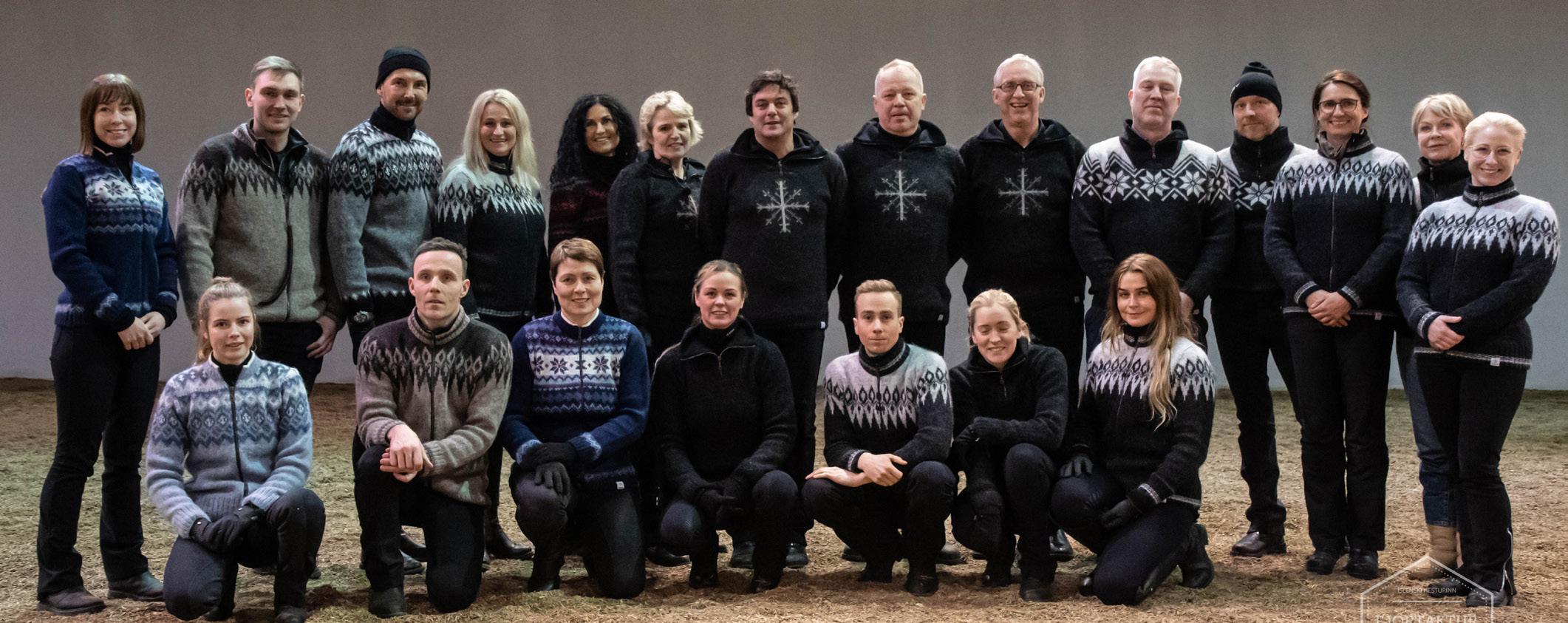
17 minute read
Speaking the same language
for example the shoulder-in and travers. A lot of emphasis was put on the horse’s well-being during exercises, whether they are collecting or flexible, because only then the exercise actually pays off.
Tölt and balance
Next it was time for Bergur Jónsson to ride into the hall in Gráfeldur frá Syðri-Gegnishólum which is four years old. The goal was to demonstrate how you can teach a horse to tölt without making the tölt into some kind of punishment by forcing it to do it. Julio talked about how the horse had to enjoy itself on tölt and little by little gain balance. Naturally, Gráfeldur was still imbalanced in tölt. On the other hand it was very soft and his topline relaxed and in moments behind the vertical line. Julio and Dr. Susanne Braun veterinarian explained the difference between rollkur and when horses are soft in their topline and with their heads vertical or right behind the vertical line. In rollkur horses are forced below the vertical line by hand and at the same time pressure is put on them to walk underneath them with their hind legs and in this situation their topline is tense. It was necessary for this discussion to take part and explain to equestrians that there is a significant difference between the two. It was meaningful for all equestrians to realize that in certain stages of training it is normal for horses to be imbalanced in some gaits and having more weight in their front legs. Out in nature horses carry more weight in their front part. This is why trainers put so much effort into training horses to put the weight in their back part in order to increase their health and durability as riding horses. This kind of demonstration could and should be done more often. Showing horses which are in different stages of training improves the minds of riders by showing us that there are a lot of obstacles to overcome in order to fully train a horse. Horse training can be compared to a child taking its first steps in musical school, first a basic understanding has to be built before the child can eventually play Johann Sebastian Bach‘s symphonies seamlessly.
Elin Holst riding Frami frá Ketilsstöðum and Brynja Amble riding Goði frá Ketilsstöðum well dressed up. Photo: Bjarney Anna
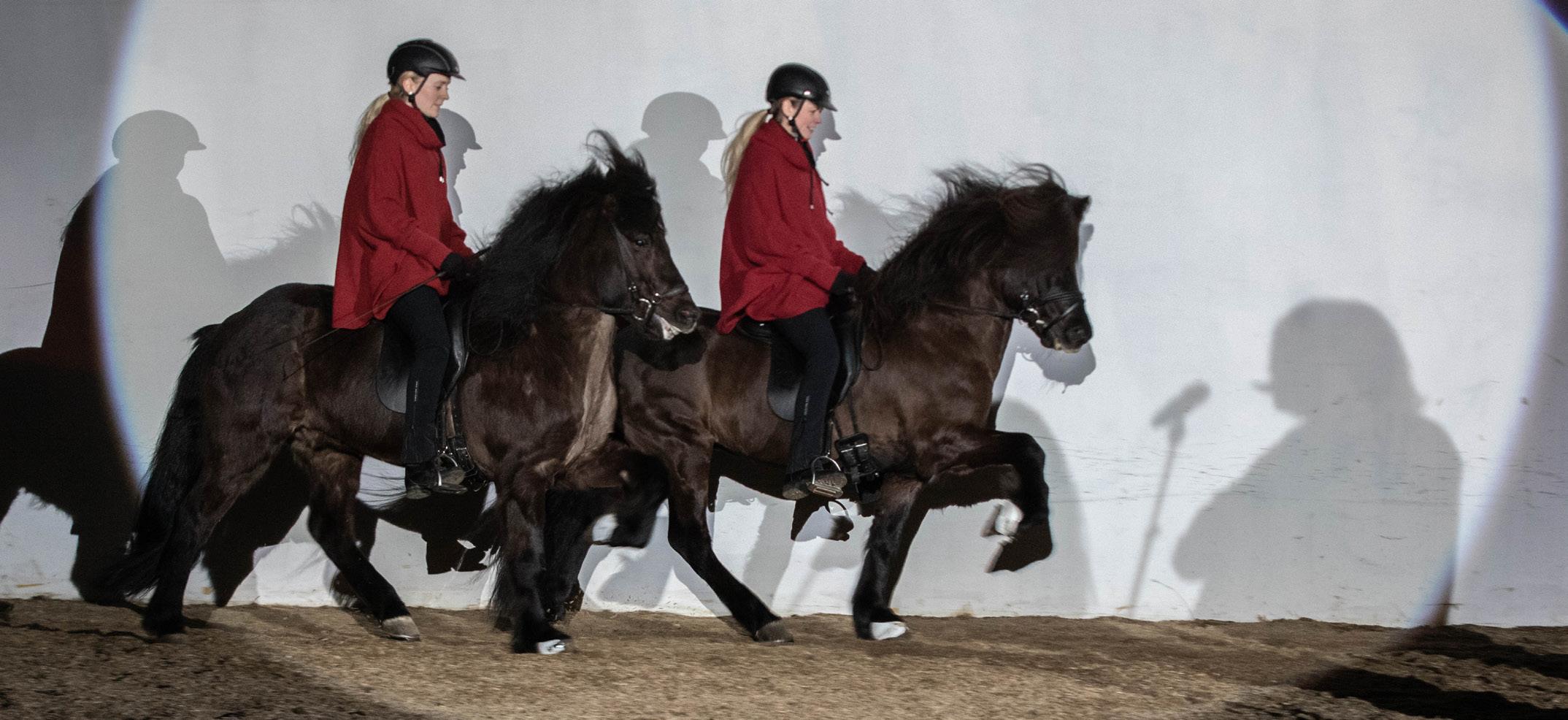
Every trainers final goal is a collected horse which walks straight with a clean rhythm, with its neck as the highest point and the nose in front of the vertical line.
Promlem solving
Next, Ragnhildur Haraldsdóttir, Kristín Lárusdóttir and Jakob Svavar Sigurðsson came into the hall one by one with horses and had Julio Barba assist them with their horses which all had different kind of problems. At times it was hard to see what exactly they were looking for, but the biggest learning point was, that sometimes one problem leads to another. Riders come forward to get answers to certain problems which are not necessarily there in that moment, which is why the lesson has to flow with the feeling of the rider and the trainer.
Off to pace!
Next it was time for pace training. Bergur came into the hall riding Stinna frá Ketilsstöðum and instructed guests about pace training. Same as the other acts, the horses well-being, happiness and relaxation is the most important step when pace training. A content horse which walks forward willingly learns to pace quickly and in the beginning the sprints are short. Elin Holst showed Spurning frá Syðri-Gegnishólum in pace and took a few asperous sprints.
Speed changes in tölt
Next on the agenda was a competition in speed changes and those who participated were Sigursteinn Sumarliðason, Kári Steinsson and Kristín Lárusdóttir. Sigríður Pjetursdóttir FEIF international judge was asked to judge the

Live music performed by the radiant Jóhanna Guðrún and Davíð Sigurgeirsson. Photo: Bjarney Anna
competition and at the same time justify her numbers. The riders were asked to display their opinions and Julio Barba was also asked to describe his speed changing experience. Sigríður started by explaining what judges seek for when speed changes are shown and after she had explained each of the riders demonstrated a few speed changes. The idea behind having the judge and the rider conversate is great but the question is whether it was suitable for this demonstration. In the end Julio rode Glampi frá Ketilsstöðum and demonstrated a typical training session. It was very fun to be able to observe Julio and Glampi because their interplay was absolutely beautiful.
New standard
In the evening the Galashow took place and you can say that new standards were set. Live music and Jóhanna Guðrún’s singing set a festive tone to the show and sometimes the music and equestrianism sent shivers down the authors spine. Most of the demonstration acts were phenomenal and it was clear that riders put a lot of effort into professional and beautiful riding. The whole day was great fun, informative and an honour to those who were responsible for it. Julio Borba is humble towards the Icelandic horse and the methods he has to offer are thought out to have the horse’s best interest in the foreground. This day emphasized the quality of the Icelandic horse which seems to be able to solve all roles that it’s offered.
Commentators
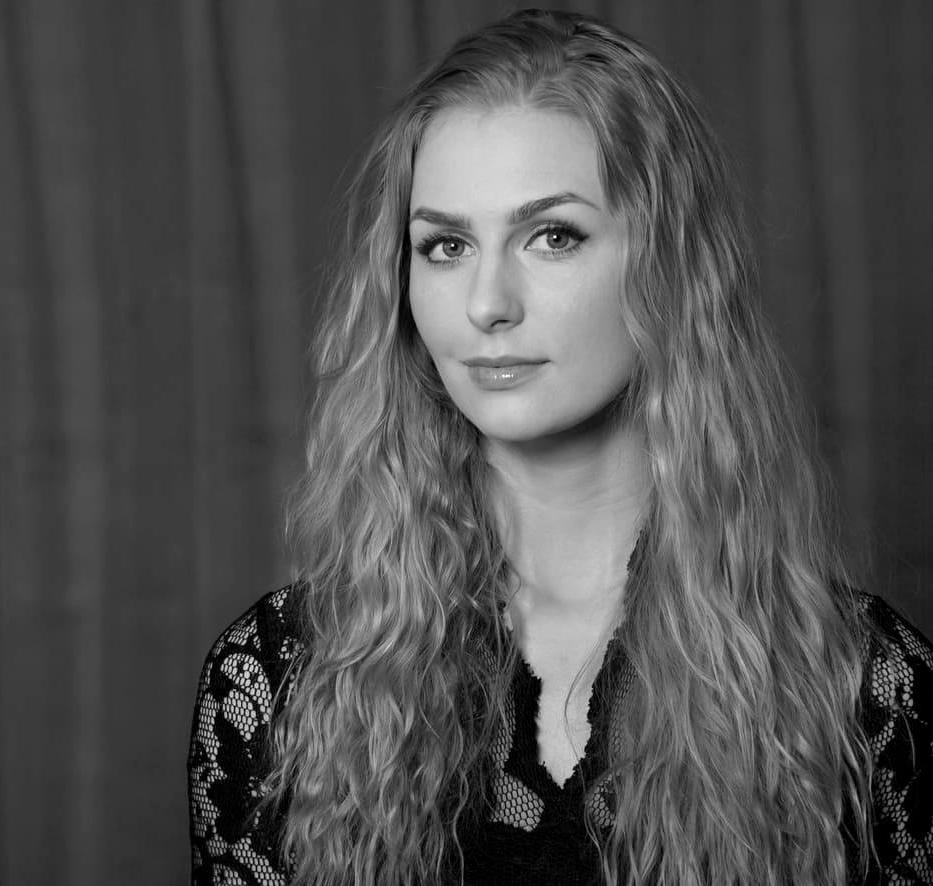
Fanney Hrund Hilmarsdóttir
I think it was very strong to give the audience the context; that is, to show the training process from a young horse to an educated horse. It is quite common at riding demonstration to go over „a traditional training session “of a well-educated horse. After the demonstration the observers go back to their stables filled with ambition from what they have experienced, only without a clue which steps are necessary to take towards a comparable goal. The incremental passage of the training process did not only give the spectator tools to work on his horse, but most importantly a well-organized toolbox. The fact is, it is not enough to have putty and paint when you go home and cannot find anything in the crowded storage and then end up painting before using the putty. I also absolutely loved Julio training Álfgrímur on the ring. That looked like unformal, flowing dance. What has always fascinated me about Julio, is that he doesn’t use the exercises just to exercise or the form just for the form, but he seems to use it to improve mental and physical balance and strength. To watch him use his body and energy in a diverse way was very enlightening and is only done by trainers that have extreme knowledge and insight into the movements of the horse, and they also understand what each emphasis and stimulation brings to the overall strength and balance. The Gala Show was a really enjoyable experience and the highlight of it was the performance of the couple in Syðri-Gegnishólar, Bergur Jónsson and Olil Amble. At the end of the day, I felt the result was that it is good to have a few very good tools in the box – tools that both horse and trainer knows well. These tools are used in a skilled and predictive way, in all circumstances, all through the training process. That does not necessary mean that all horses will become great, but they will definitely be more likely to become the best, content version of the horse they have ability to be. And what more can you ask? I could certainly not ask for a better day. Thanks for the inspiration, the tools and the toolbox.
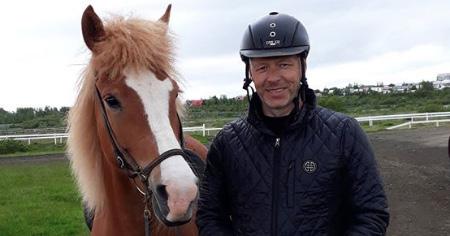
Ingibergur Árnason
I thought is was a great demonstration day and very interesting to see how much work is done with the young horses before anyone eventually gets on them. I also noticed how early on they start using side reins and with all the accuracy in the aids, both from the reins and the trainers body language. The only downside I can think of is that it was too short, because I had so many questions after watching the demonstrations and taking everything in that I experienced. So hopefully we will get a chance of another day like this. The Gala Show was incredible and a new flavor in indoor shows. These shows have often been in that way, that riders ride like maniacs to some heavy metal rock music, where the horse jumps up in the corners and you get the feeling that this has to be the riders very last ride forever! But in this show there was a totally different tone set, very professional riding and the art of riding in the foreground with live music. Three acts were my favorite ones: Olil and Bergur very professionally riding their well trained and great gædingar, Sylvía Sigurbjörnsdóttir and Árni Björn Pálsson were great on top tölters and a well rehearsed act, and then the very fast sprints in pace by Davíð Jónsson and Sigursteinn Sumarliðason through the riding hall. This amazing day was well organized in an ambitious way, where professionalism and sincerity were shining through it all. Hopefully this was only the beginning of something more.
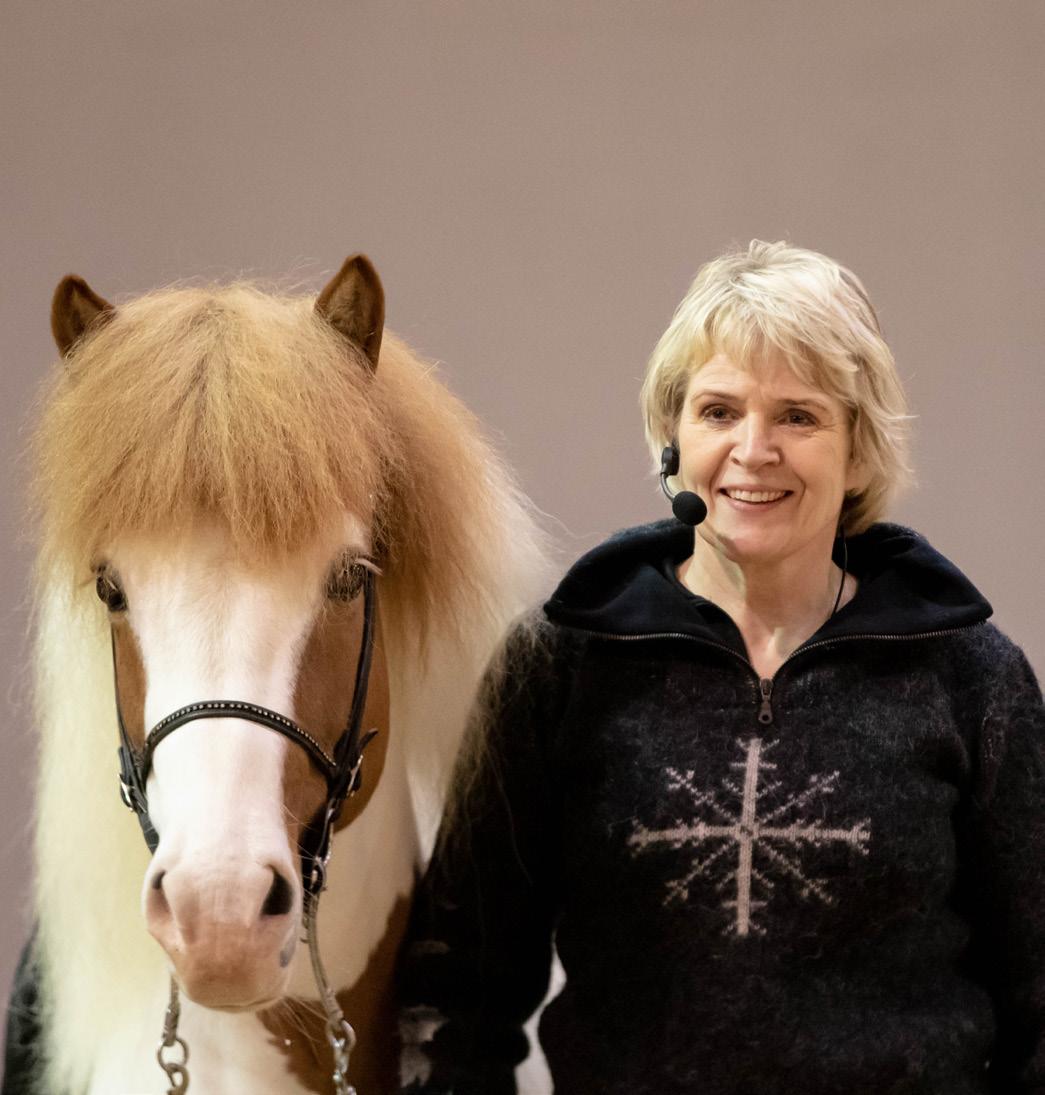
Olil Amble
On behalf of the organizing team, I would like to thank for all the good wishes we have received after the riding demonstration and Gala Show held in Fákasel. Tickets sold out in the presale and fewer people were able to watch than wanted. We found that everything went according to plan and we really felt that we got to share good things with our audience. In our opinion, this approach with the horse and audience is something that we horse people should do more of. Find a time and place to get together, enjoy our amazing horse, learn to appreciate more than high leg action and speed. Our horse is a tough Viking with excellent speed range and an accomplished Gæðingur. He is also a great leisure horse and he can also be a sensitive ballerina and danse around doing all kinds of exercises. We also found the need for more training and higher appreciation of the slow gaits and by doing so we lift our horse up to the pedestal it deserves. By hosting the ridingdemonstration we wanted to share with everyone what we have been dedicating in our art of riding in the last 15 years. Julio Borba our instructor, has been riding since he can remember, and his father and uncle along with Luís Valenca were his most important mentors. Julio was a rider in the Royal Equestrian Academy of the Portuguese Royal Court for 12 years and performed all the exercises riding horses of Lusitano breed. Since he left the Academy he has been travelling the world as a riding instructor and has already made a huge impact on the training of the Icelandic horse. Our goal for the big day in Fákasel was that everyone would be comfortable, both our staff, volunteers, riders and guests. We emphasized on being able to warm the horses up indoors, which is an important basis for modern indoor riding/ training. We thank all of our great sponsors, who supported the event with funds and work, without such help we would not have been able to pull this off, but it was a strong cooperation where many got together and worked hard so we could do things like we wanted. For that we are eternally grateful. Many thanks to you all and to the guests, this dream of ours came true thanks to you.
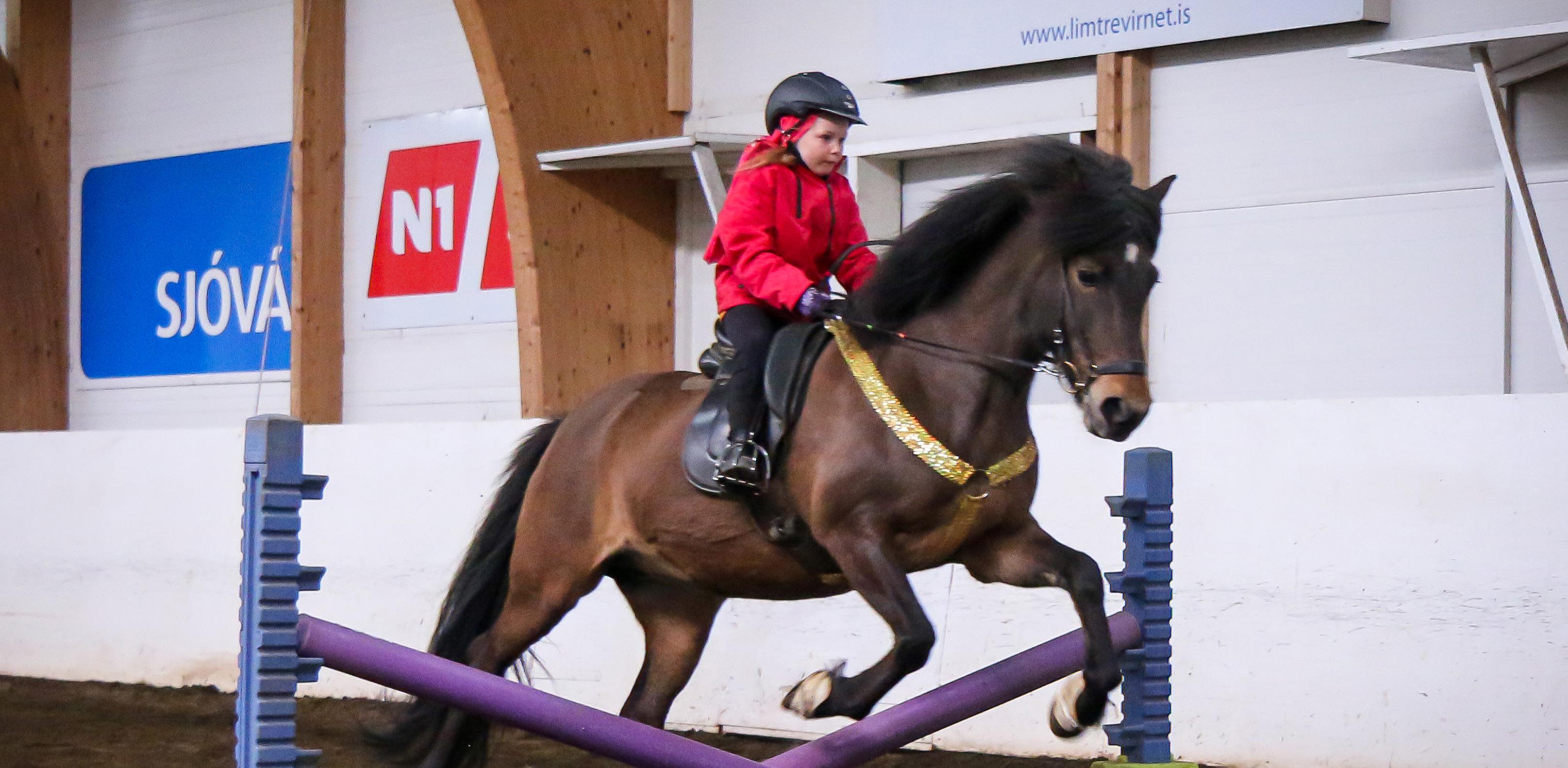
An ambitious young rider
Eiðfaxi enjoyes stories from horse people everywhere and at any age, because they all have the passion for the Icelandic horse in common. Kristín Eir Holaker Hauksdóttir is a 10-year-old rider who lives with her family on a horse farm called Skáney. Skáney is located in Borgarfjörður West Iceland about 90 minutes drive from Reykjavik. Skáney is actually one of the oldest horse breeding farms in Iceland and beginning was 70 years ago when Kristín‘s great grandfather started the breeding. After that her grandparents Birna Hauksdóttir and Bjarni Marinósson took over the farm and now her parents Haukur Bjarnason and Randy Holaker are actively taking part in running the farm today. Skáney is a busy farm because sheep and cows are also bred there and like on every farm in Iceland, dogs and cats are an essential part of the animal life on the farm. So obviously Kristín Eir is born into a family of horse enthusiasts and she has been riding from a very young age and as soon as she was big enough, she would sneak out and go riding alone on her favorite horse. At Skáney you will also find a riding school and young riders come there for clinics and lessons by Kristín’s parents. A riding school has to have solid and trustworthy horses and Kristín Eir helps a lot with their training as well as all kinds of other work that has to be done in the school. Kristín Eir likes to compete in equestrian sport and she wants to take part in the League KB mótaröðin next winter, and she is already an Icelandic
champion in dressage, only 10 years old, competing against kids aged 10-13 years. Kristín has ambition to be a great rider and horse breeder who loves the farm life, and we are most certainly going to keep a good eye on her in the future. Kristín answered a few questions for Eiðfaxi: Birthday: July 20th Zodiac sign: Leo Age: 10 years old Home: Skáney, Borgarfjörður School: The elementary Grunnskóli Borgarfjarðar, Kleppjárnsreykir Horse club: Borgfirðingur Other hobbies: Basketball, Karate and playing piano
Most fun to do with the horse:
Compete, horse tours and ride bareback. Favorite gait: Gallop and pace The most fun horse: Dama frá Skáney, five gaited mare Favorite stallion: Sólon frá Skáney and Ellert frá Baldurshaga Your first horse: Sól frá Skáney. My grandparents gave me her as a christening gift. She is the same age as me.
Most fun horse related memory:
The Landsmót in Hólar 2016 was so much fun! My mum was pregnant with my sister Sara and we slept in the Camper which I love. I liked to visit the Hólar University and being there for so many days with them. We played in a theme park, saw a play and went to a ball. Role models: Mum, dad and Jakob Svavar
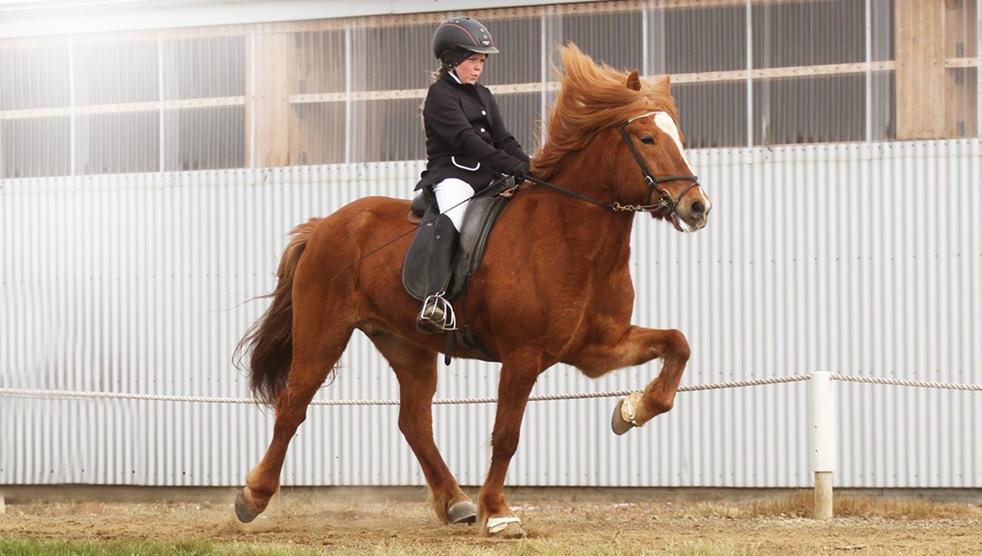


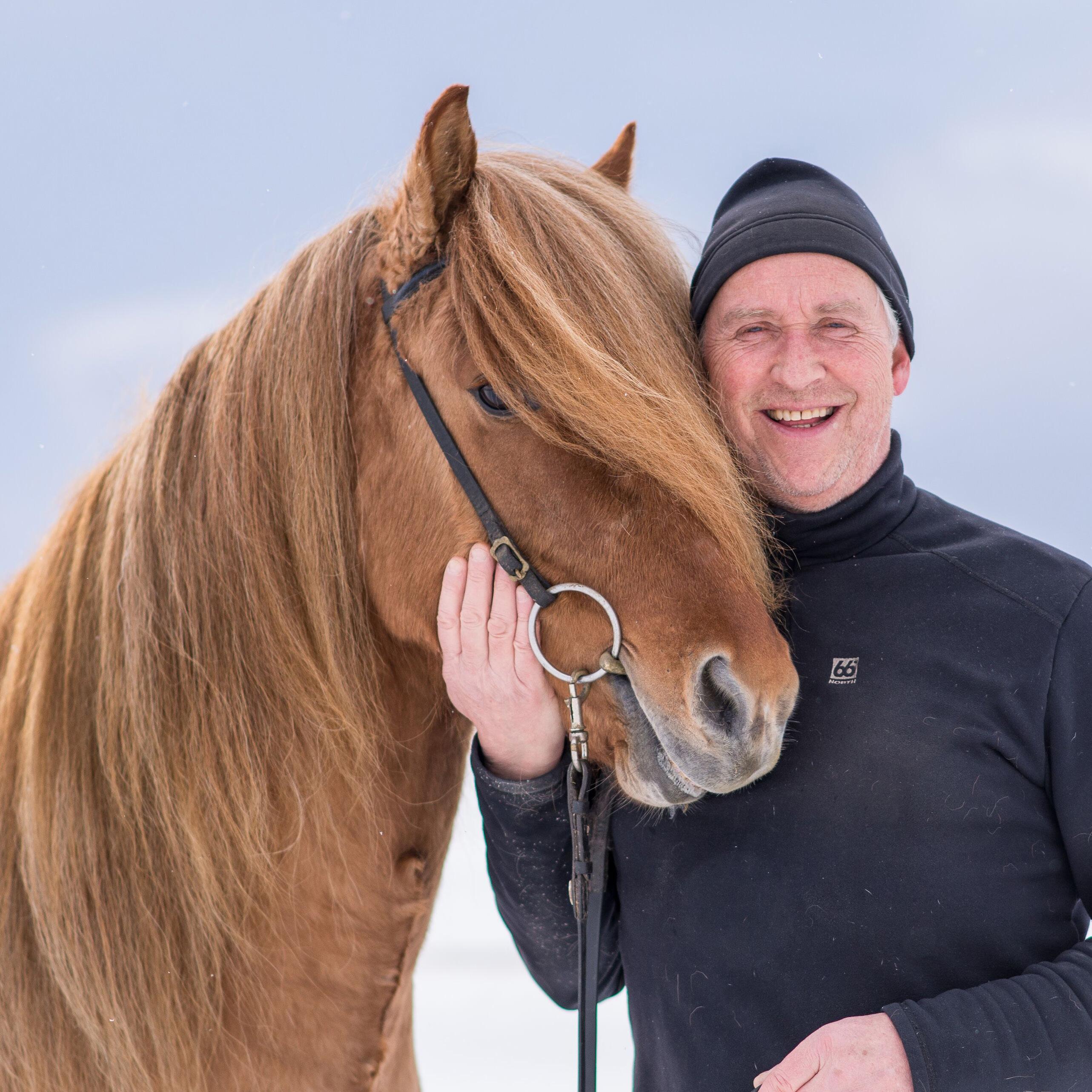
I am actually rather shy
Hafliði Halldórsson celebrates 60 years
The word entrepreneur is sometimes used when describing men who not only have a vivid imagination and great ambition but are also driven to make their ideas come to life. Hafliði Halldórsson is one of those men and he has often flown quite high in ideology and implementation. Recently Hafliði turned sixty years old and sat down with Eiðfaxi to reflect on his very eventful life.
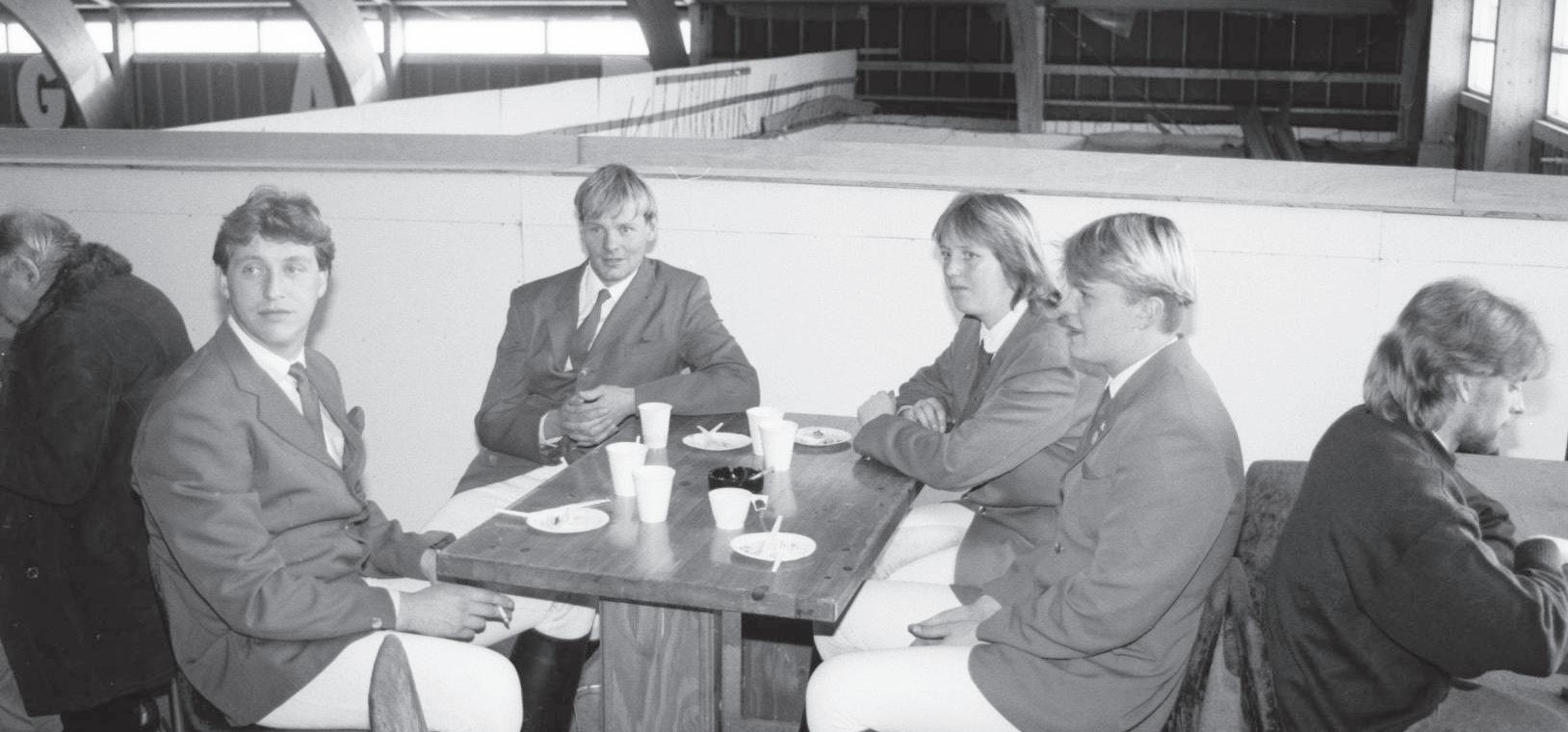
Good old days. Hafliði with his collegues in the Riders association in the Fákur riding hall in 1990. From left: Hafliði, Þórir Örn Grétarsson, Maaike Burggrafer and Hinrik Bragason. Photo: Eiðfaxi.
The beginning
Hafliði Halldórsson was born on the 7th of February in Reykjavík in 1960 and was the fourth born out of six siblings. „My mother is from Hergilsey in Breiðafjörður and my dad was from Reykjavík. The first years of my life we lived in Fossvogur area in Reykjavík and I attended school at Breiðagerðisskóli. No one in my family was riding horses during those years but by that time I was completely fascinated by horses. I walked down to the stables at Neðri-Fákur.“ At the time the riding club Fákur had the club’s stable there as well as in Laugardalur where the Reykjavík Park and Zoo is now, Hafliði was a regular at both places. „I walked around the stables and spotted some beautifully coloured horses that in my dreams ‘belonged’ to me. I got free bread at the nearby bakeries and fed it to the horses. One time I had stuffed some bread inside my jacket and crawled on all fours along the stable floor. Before I knew someone had snatched me up and I was hanging by my jacket. I looked up and saw that it was a horse that had managed to get a hold of me. There I was, hanging from its mouth for a little while until one of the shepherds saw me and nudged the horse with a broom stick. The horse let me go and I fell to the ground. This is one of my first horse related memory”. To begin with, Hafliði‘s equestrianism consisted of combing and holding on to horses that he got permission to do. This led to his first riding
course with Guðrún Fjeldsted, a riding instructor who was located in Neðri-Fákur stable area. When he was twelve years old, he went to the countryside to a farm called Innsti-Vogur near Akranes, to work for Þórólfur Pétursson. „Me and my friend, Jón Árnason, went there together to work. Today Jón owns a horse farm which is called Skipaskagi and is located at a farm called Litla-Fellsöxl. Me and Jón stayed with Þórólfur at Innsti-Vogur for two summers. The second summer Þórólfur was moving to the north of Iceland. I was asked to drive the belongings all the way from Innsti-Vogur to Hjaltastaðir. Among those things were three ancient and open tractors with rear trailers which the rest of the househould things were stacked upon. My packed lunch for the trip consisted of milk in a bottle and biscuits from Frón and with that I made my way from Akranes to Skagafjörður in the North, about 300 kilometers. I got to Skagafjörður in the middle of the night and took the bus from Varmahlíð back to Akranes at 8 in the morning. When I got back to Innsti-Vogur the next fully stacked tractor was waiting for me. I also drove the second tractor North as well as the third. That summer I was 13 years-old.“ The following winters Hafliði started to work more at Fákur, e.g. as a shepherd and shoeing horses as well as starting to train young horses. „At that time Fákur is an extensive organisation with community stables for hundreds of horses and numerous men on their payroll. The late Bergur Magnússon was the chief executive officer, CEO. He was very strict and made great demands on the employees. Him and I got along well and became great friends. He trusted me enough to take over Fákur‘s training center which was a great deal back then and there I was, practically still a teenager, made responsible for the operation of the training center. It was a very i nformative time for me, and you can say that there are three men that are responsible for my discipline, hard work and finishing what I start. These men are Bergur, Bogdan Kowalczyk former coach of the national handball team and Sigurbjörn Bárðarson. Each of them a hard-working man that made great demands on himself and on those who worked for him.“ Not everyone knows that in his teenage years Hafliði was among the most promising handball players in Iceland. He trained with the handball clubs Íþróttafélag Reykjavíkur and Víkingur and was in both the under-17 and under-21 national teams. Inevitably it came to choosing between handball and training horses. “I chose training horses over handball purely because it was a profession while handball was a hobby. At the time there wasn’t any money in handball, so the choice was easy in the end. However I am still a highly interested handball fan and I greatly enjoy watching the national team which my friend Guðmundur Guðmundsson coaches with favorable reputation”.
Horse training takes over
In the early 80‘s Hafliði was intensely occupied with training horses at Fákur where there was never a lack of work. „The Day of the Horse in 1980 is memorable for me because I had the honour to showcase the monarch himself, Hrafn frá Holtsmúla at Melavöllur. It was quite the experience for a young trainer, something I will never forget”. In the winter 1984 -1985 Hafliði started working for Sigurbjörn Bárðarson in Víðidalur and stayed with him until 1988.










